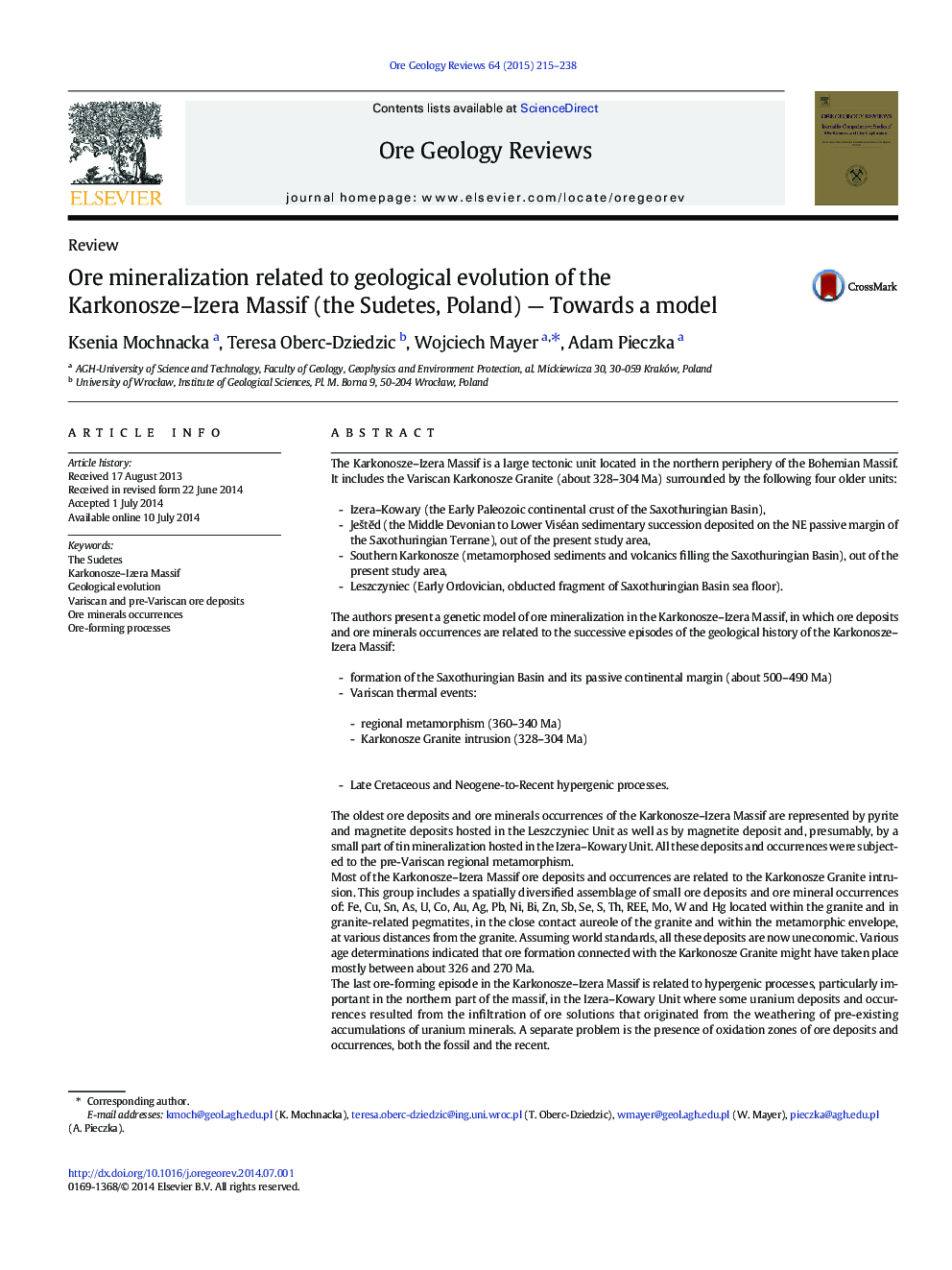| کد مقاله | کد نشریه | سال انتشار | مقاله انگلیسی | نسخه تمام متن |
|---|---|---|---|---|
| 4697115 | 1637239 | 2015 | 24 صفحه PDF | دانلود رایگان |

• Formation of the Saxothuringian Basin and its passive continental margin (500–490 Ma).
• Variscan regional metamorphism (360–340 Ma).
• Karkonosze Granite intrusion (312 Ma)
• Late Cretaceous and Neogene-to-Recent hypergenic processes.
The Karkonosze–Izera Massif is a large tectonic unit located in the northern periphery of the Bohemian Massif. It includes the Variscan Karkonosze Granite (about 328–304 Ma) surrounded by the following four older units:-Izera–Kowary (the Early Paleozoic continental crust of the Saxothuringian Basin),-Ještĕd (the Middle Devonian to Lower Viséan sedimentary succession deposited on the NE passive margin of the Saxothuringian Terrane), out of the present study area,-Southern Karkonosze (metamorphosed sediments and volcanics filling the Saxothuringian Basin), out of the present study area,-Leszczyniec (Early Ordovician, obducted fragment of Saxothuringian Basin sea floor).The authors present a genetic model of ore mineralization in the Karkonosze–Izera Massif, in which ore deposits and ore minerals occurrences are related to the successive episodes of the geological history of the Karkonosze–Izera Massif:-formation of the Saxothuringian Basin and its passive continental margin (about 500–490 Ma)-Variscan thermal events:-regional metamorphism (360–340 Ma)-Karkonosze Granite intrusion (328–304 Ma)-Late Cretaceous and Neogene-to-Recent hypergenic processes.The oldest ore deposits and ore minerals occurrences of the Karkonosze–Izera Massif are represented by pyrite and magnetite deposits hosted in the Leszczyniec Unit as well as by magnetite deposit and, presumably, by a small part of tin mineralization hosted in the Izera–Kowary Unit. All these deposits and occurrences were subjected to the pre-Variscan regional metamorphism.Most of the Karkonosze–Izera Massif ore deposits and occurrences are related to the Karkonosze Granite intrusion. This group includes a spatially diversified assemblage of small ore deposits and ore mineral occurrences of: Fe, Cu, Sn, As, U, Co, Au, Ag, Pb, Ni, Bi, Zn, Sb, Se, S, Th, REE, Mo, W and Hg located within the granite and in granite-related pegmatites, in the close contact aureole of the granite and within the metamorphic envelope, at various distances from the granite. Assuming world standards, all these deposits are now uneconomic. Various age determinations indicated that ore formation connected with the Karkonosze Granite might have taken place mostly between about 326 and 270 Ma.The last ore-forming episode in the Karkonosze–Izera Massif is related to hypergenic processes, particularly important in the northern part of the massif, in the Izera–Kowary Unit where some uranium deposits and occurrences resulted from the infiltration of ore solutions that originated from the weathering of pre-existing accumulations of uranium minerals. A separate problem is the presence of oxidation zones of ore deposits and occurrences, both the fossil and the recent.A full list of ore minerals identified in described deposits and occurrences of the Karkonosze–Izera Massif together with relevant, key references is presented in the form of an appendix.
Figure optionsDownload as PowerPoint slide
Journal: Ore Geology Reviews - Volume 64, January 2015, Pages 215–238